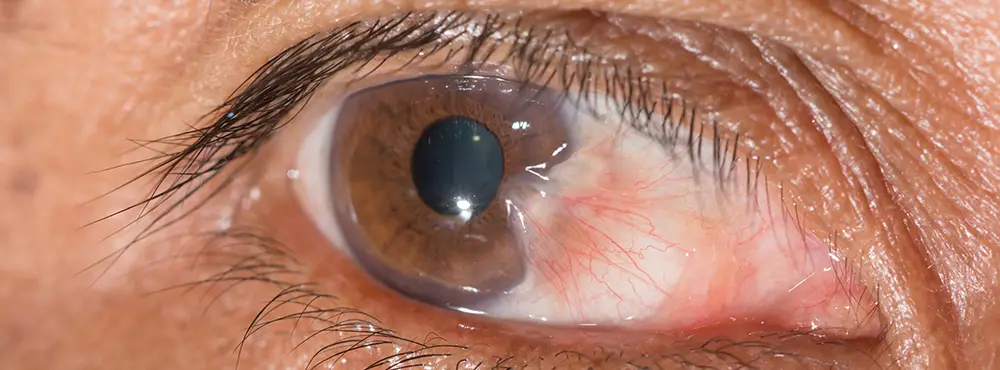How do you treat pterygium?
Surgery is sometimes required as a treatment to remove a pterygium, especially if it is causing sight problems. However, this depends on the size and whether it’s growing.
Surgery for this procedure is rare in the UK as most cases can be managed by using eye drops to reduce inflammation and keep the eye lubricated. Regular sight tests are important to monitor growth and/or any other changes.
You may be prescribed mild steroids or lubricants by your eye care professional/ optician. These reduce swelling, redness, dry eyes and other irritating symptoms. Other treatments include topical cyclosporine and sometimes contact lenses are used to cover the growth and to protect the eye from further UV exposure.
Pterygium eye surgery
If surgery is required (for both visual and cosmetic reasons), there are several surgical techniques available. Your ophthalmologist will determine which treatment suits you best before operating, which usually takes no more than 30 minutes.
In some cases, pterygium removal can cause astigmatism or worsen the condition for those who already have it. Your eye will need to be monitored after surgery for the recurrence of growth and you’ll need to use eye drops for several weeks after the removal. You'll also need to wear an eye patch to protect the eye for a few days, though you should be able to return to doing regular activities the next day.
It isn't uncommon for pterygia to return after surgery should the eye be continuously exposed to high levels of UV rays.
There are some preventative measures you can take to reduce the chances of reoccurrence. Wearing sunglasses with built-in 100% UVA and UVB protection will limit your exposure to ultraviolet and offer sufficient eye protection. You can also opt for photochromic sunglasses or Transitions; these feature lenses which change tint depending on the surroundings. For example, they will darken in bright and sunny conditions and lighten when indoors or when it is cloudy outdoors.
Our entire range of sunglasses has 100% UVA and UVB protection, while we also stock sports sunglasses from O’Neill and Oakley for athletes and active individuals.
Mitomycin C, an agent that prevents scarring by inhibiting the reproduction of cells that produce scar tissue, may be applied at the time of or after the surgery.
Another option of pterygium surgery is a conjunctival autograft. It involves removing the limbal tissue and adjacent conjunctiva from one part of the patient's eye and using it to cover the spot where the pterygium was. This procedure is more likely to prevent the pterygium from growing back.
Can pterygium go away on its own?
While a pterygium may look and seem alarming, it is possible for it to go away without any treatment whatsoever. However, an eye care specialist is best to decide the severity of the pterygium and determine whether surgical removal of the pterygium is necessary.
Pterygium Diagnosis
Your optician will be able to diagnose a pterygium by taking a close look at your eyes with a magnifying slit lamp. They will be able to distinguish the growth from other eye conditions such as dry eye, red eye and pinguecula.
In addition to a slit lamp test, they will also use an eye chart to test your visual acuity as well as take photos to monitor the growth of the pterygium. They will also see you on a regular basis for eye exams.
What are the best eye drops for pterygium?
Artificial tears and over the counter eye drops, for example, Systane Lubricant Gel Drops, Blink eye drops can relieve irritation and redness caused by pterygium. However, it is best to speak with your optometrist regarding which eye drops or ointments are suitable for you. An ophthalmologist can prescribe specialist eye drops.
Quick links:
A guide to dry eyes
Protecting eyes from UV rays
Sunglasses with UV protection
Disclaimer: The advice in this article is for informational purposes only and does not replace medical care or an in-person check-up. Please check with an eyecare professional before purchasing any products or remedies. For information on our article review process, please refer to our Editorial Policy.

 Offers
Offers Account
Account
 Favorite
Favorite
 Basket
Basket

 OFFERS
OFFERS


















